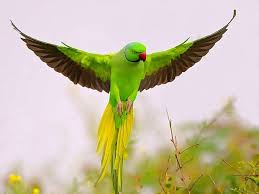
ScientificName:Psittaciformes
LifeTime:12 years
Kingdom: Animalia
Phylum: Chordata
Class: Aves
Clade: Psittacopasserae
Psittaciform diversity in South America and Australasia suggests that the order may have evolved in Gondwana, centred in Australasia.[4] The scarcity of parrots in the fossil record, however, presents difficulties in confirming the hypothesis, and there is currently a higher amount of fossil remains from the northern hemisphere in the early Cenozoic.[5] Molecular studies suggest that parrots evolved approximately 59 million years ago (Mya) (range 66–51 Mya) in Gondwana. The three major clades of Neotropical parrots originated about 50 Mya (range 57–41 Mya).[6] A single 15 mm (0.6 in) fragment from a large lower bill (UCMP 143274), found in deposits from the Lance Creek Formation in Niobrara County, Wyoming, had been thought to be the oldest parrot fossil and is presumed to have originated from the Late Cretaceous period, which makes it about 70 million years old.[7] However, other studies suggest that this fossil is not from a bird, but from a caenagnathid oviraptorosaur (a non-avian dinosaur with a birdlike beak), as several details of the fossil used to support its identity as a parrot are not actually exclusive to parrots, and it is dissimilar to the earliest-known unequivocal parrot fossils.[8][9] It is generally assumed that the Psittaciformes were present during the Cretaceous–Paleogene extinction event (K-Pg extinction), 66 mya. They were probably generalised arboreal birds, and did not have the specialised crushing bills of modern species.[5][10] Genomic analysis provides strong evidence that parrots are the sister group of passerines, forming the clade Psittacopasserae, which is the sister group of the falcons.[11] The first uncontroversial parrot fossils date to tropical Eocene Europe around 50 mya. Initially, a neoavian named Mopsitta tanta, uncovered in Denmark's Early Eocene Fur Formation and dated to 54 mya, was assigned to the Psittaciformes. However, the rather nondescript bone is not unequivocally psittaciform, and it may rather belong to the ibis genus Rhynchaeites, whose fossil legs were found in the same deposits.[12]
Parrots, also known as psittacines /ˈsɪtəsaɪnz/,[1][2] are birds of the roughly 393 species in 92 genera comprising the order Psittaciformes, found mostly in tropical and subtropical regions. The order is subdivided into three superfamilies: the Psittacoidea ("true" parrots), the Cacatuoidea (cockatoos), and the Strigopoidea (New Zealand parrots). One-third of all parrot species are threatened by extinction, with higher aggregate extinction risk (IUCN Red List Index) than any other comparable bird group.[3] Parrots have a generally pantropical distribution with several species inhabiting temperate regions in the Southern Hemisphere, as well. The greatest diversity of parrots is in South America and Australasia. Characteristic features of parrots include a strong, curved bill, an upright stance, strong legs, and cl